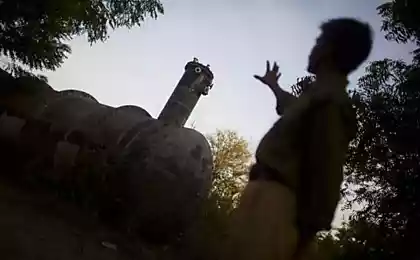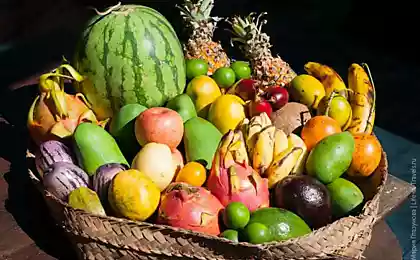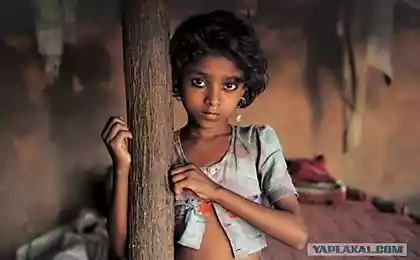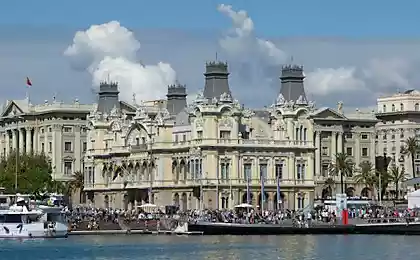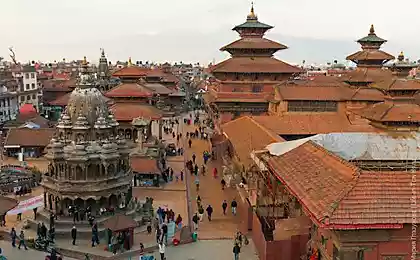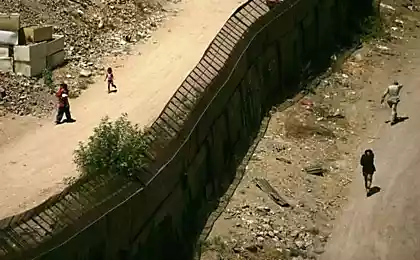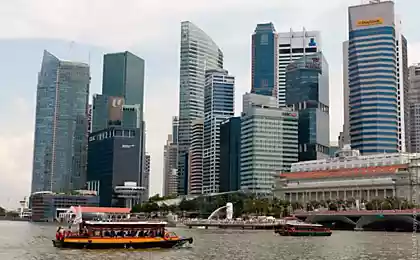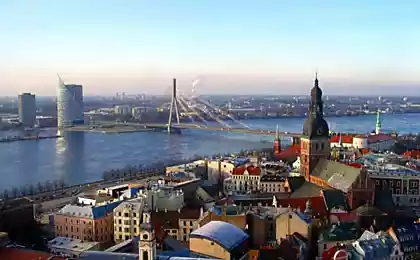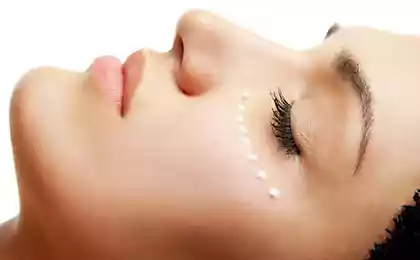719
50 facts about India through the eyes of Russians
1. As a gesture of "yes" (rather than a nod, as we do) Indians rocking his head to the side, like our "ah-ah-ah." First time unconsciously had the feeling as if they reproachfully shake their heads in response to a question, they say, "Well, question for you, white." Similarly, at the meeting - often start talking head from side to side, like dolls, very funny))
2. The movement is left-hand, such a thing as the SDA, if it exists, it is very arbitrary, the main rule of the road - a beep. Moreover, in contrast to, for example, from the pointer povortnikami, toot is more preventive in nature, ie. E. Pobibikal and immediately begins to rotate, and if not lost - your problems, you are in fact warned =) especially frenzied traffic in major cities - Delhi, Chennai, Calcutta, usugblennoe incredible amount of fat-the fat, scurrying here and there - hum signal does not stop there for a moment.
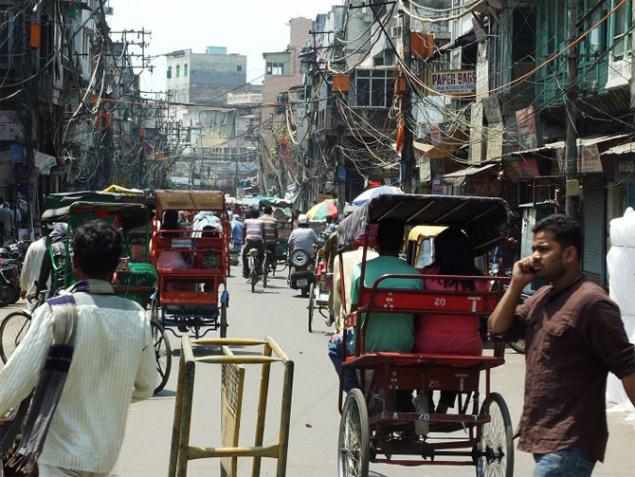
3. Among men distributed a close friendship, to such an extent close that there can often meet them walking holding hands or hugging. We were surprised at first, but then read that this is just the kind of friendship without sexual connotation.
4. Indian cuisine, especially the southern, very spicy, with lots of spices. Requests «no spicy», «no chilly» rarely lead to the expected result, despite the diligent waiter nodded. There is a certain set of dishes, initially not very sharp - they can eat at the total rejection of spicy food.
5. In most cases, to designate the places where you can eat, the word Hotel. The majority of hotels called the Lodge, but some, especially large ones, are also used in the title Hotel.
6. The most common fruits: papaya, pineapple, tangerines and bananas, the latter a huge number of varieties - large and small, thick and thin, yellow, red and green. Often sold well and apples, but incredibly expensive.
7. Many of the products is marked MRP (maximum retail price) - the maximum retail price at which the product may be sold. This is especially noticeable on bottled water, which is sold on every corner, and costs almost everywhere 15 rupees per 1 liter in the shops and in cafes.
8. In many small local restaurants are no menus - people come and bought them for a long time known dishes.
9. dishes for different meals usually clearly separated for breakfast (up to 11), lunch (12 to 15) and dinner (from 19 to 21). Time, however, is quite conditional and can vary, but the day ordered something from the menu, breakfast, dinner and a day of often fail. Despite the fact that from 15 to 18-19 of the general cafes are closed.
10. The most common meal among the not very wealthy citizens - a Meals: a mountain of rice, usually on a banana leaf (very convenient, free disposable tableware, and more profitable in the waste management) with several sauces and condiments in bowls. Most often, this dish without restrictions - sauces pour almost always, sometimes and rice enclose, cheap and cheerful.
11. Tipping in cafes customary to leave at will by 3-10%, but most often it is 10-20 rupees.
12. Alcohol is not commercially available. t. e. it is not forbidden, but not particularly welcomed - can be bought only in designated areas. Most cafes it also officially not (sometimes sold "under the counter"), have only in restaurants.
13. Staff at the guesthouse and cafes, especially low-cost, rarely friendly. They are not aggressive, but speak as if they have this work in the liver sits perhaps the way it is. And the locals are often very smiling and friendly.
14. Rickshaws and other "helpers" for the client drive to the hotel as the right to receive a fixed amount, and for every night spent by the client at the hotel. So with room for 250 rupees rickshaw will get 50 rupees and 300 for 75 and so on. In each city, their fees. This us a secret shared owner of the guesthouse in Allepey =)
15. Central hot water nowhere. The cheap guest-houses, hot water is not, in principle, to bring some of it in a tank in the morning (sometimes for more money) to have more advanced boilers.
16. Toilet paper Hindus do not enjoy, instead, advanced the field next to the toilet hanging a small Dusík, and in places easier - water tap and a bucket.
17. Hindu temples begin to work at 5 am and it is usually accompanied by a loud howling (prayer) into the microphone in the whole district, on the street exposed huge speakers)) is particularly fun if such a Temple is under the windows of the guesthouse =)
18. Most of the Indians are very devout believers. The temples everywhere you turn, everywhere many pilgrims and as a result, is widely developed business selling offerings: as a rule, a set of flowers and fruits (bananas, coconuts). Some even have a small house with a prayer room of the altar and deities, visiting one of kauchserferov witnessed the evening prayer of his daughters - rang the bell and waving sticks of incense.
19. In the majority of Hindu temples or prayer in certain parts of their entrance is permitted only Hindi, while the Indian bless "pop" can and Europeans (to put a point on the forehead with holy water wash), as long as the money paid)
20. Probably because of the heat, most people here stands at 5-6 am. So at 7 am normal weekday, we have seen the crowds on the beach - Local played football, volleyball and just sat in groups or walking, the same thing in the evening - after 5:00.
21. Indians for the most part do not like to swim in the sea prefer the lake with fresh water and no waves. Women never bathe, at least in public.
22. Often, local, mostly young people from non-tourist areas are asked to take a picture with us. Kids just say hello and wave their hands or ask them to take pictures. People in the age and willingly pose in front of the lens, and then with innocent eyes asking "mani-mani».
23. A typical procedure dating from local consists of two issues of "HIV country ?, Neum?". Sometimes just asking "Neum?" And go beyond satisfied.
24. The children, seeing us often ask, "sculptor". Initially I did not understand, and then dismantled - school pen (pen school), probably tourists often they are presented.
25. The most common clothing for women - a sari, young men wear jeans and T-shirts, and the older generation often prefers lungi - a cloth wrapped around his legs, wound over his naked body.
26. trains, cars in general (class general), if there is availability, people quietly go on luggage racks. Retrieved on their own experience - in the luggage rack can hold up to 3 people + luggage =)
In class sleeper cars on the two side shelves can be placed up to 5 people - 2 at the top, 3 at the bottom, and in the reserved seat, where we are going, four in Russia, 6 shelves here, but sleep and sit on them, six, and 9- 10 people, and a bunch of sleep, and sleep in the aisles and on the floor in the vestibules at the entrances and toilets. Each car of type 2 toilets - Western style (toilet) and Indian (hole in the floor).
27. Prices of visiting various parks, palaces and nature reserves often differ for local and foreign tourists usually 10, sometimes 15 times, such as 10 and 150 rupees.
28. Yoga and Ayurveda - the two big myths about India. In Russia, many people believe that in India all Hindus polls do yoga and Ayurveda are treated, but both are more common outside of India, and is popular mainly among tourists
29. In India, a lot of "pure" vegetarians, t. E. Those who not only do not eat meat / fish / eggs, but do not allow the preparation of animal food in the kitchen or using the same dishes / table / refrigerator storage and cooking products. In this regard, it allocated a special group of cafes and restaurants marked «pure vegetarian», which means the complete elimination of any linkages with non-vegetarian food.
30. Milk and milk products (Kurd, lassi) Hindus belong to vegetarian cuisine, explaining that the use of milk the animal does not die, unlike the eggs, which are ruined life.
31. drink bottled water without touching the neck and poured directly into the mouth. We do not succeed this trick once.
32. Washing machine in the apartment of an Indian - a rarity. And those families who can afford it, as a rule, use the services of domestic workers, which was removed and washed, and sometimes cook. In poor families, wash by hand in a river or lake.
33. India is very cheap labor - 3000 rupees (1,800 rubles) per month for a daily (!) Cleaning 3-room apartment / house and cooking dinner for 3-4 persons. If cleaning is required 2 times a day and need a breakfast, the RFP for this employee was 5000 rupees per month, even in the expensive city of Mumbai. On the quality of cleaning are not talking, not all the Hindus of the staff, even in the hotels or cafes, doing their job properly.
34. The salary of a young specialist in a major city, with experience of 1-2 years, after university in the field of IT or banking is 50-60 thousand rupees.
35. The rent for a house or apartment (3-4 rooms) in a small town is 6-10 thousand rupees, but for a 2-bedroom apartment in the north of Mumbai, has 50 thousand.
36. In the southern states in the local buses no windows - just bars on the windows that can be closed with metal shutters.
37. The bus across the room under the roof stretched rope with a bell on the end. If you need a stop, the conductor or passenger pulls the rope and about driver is heard jingling.
38. If the bus at the bus stop away from under the nose, enough to knock on board, the conductor will hear and look out, opened the door, and the driver will stop.
39. Even in large and developed city in the middle of the day you can sometimes see the peasant (probably visiting from the provinces), celebrating small need. In order not to attract attention, he squats next to a fence, behind a parked car or bus and rolled lungi sitting doing his job.
40. Camel can be bought for 25 thousand rupees - it is convenient to have, it is unpretentious in food and can carry large loads. But the elephant - animal expensive, but also more profitable, as is very popular among tourists.
41. In India, very cheap mobile communications: in terms of call and sms rubles 70 kopecks, roaming from other states - 1 ruble. Mobile Internet 70 rubles a month for 1 GB.
42. Station in any city in the evening and at night turns into a "rooming house" - the majority of Indians traveling in his bag have a blanket or bedspread. In the evening it turns into a bed on the floor in the waiting room or even in the middle of the hall. Bag used as a pillow.
43. In the northern states, many Indians eat on the floor (and not only in poor families). At the same tables and chairs in a house there, but used for another purpose, such as for storing things. Once, at a party, we hesitate to offer to sit on the floor for meals and put on high chairs in front of the bed, which was covered with "table" with treats.
44. Not all local cafes has a toilet but sink for washing hands is an absolutely everywhere - is a mandatory attribute, as most Indians eat with their hands.
45. Street coffee and tea is poured into clay pots, which are automatically disposed of after a couple of rain. Buy pots of the poor are cheaper than plastic and paper (1 paper cup costs about 7 cents, and clay is even cheaper, you can imagine what crumbs clinging makes this dish).
46. Go to the autorickshaw (passenger seat is designed for rear seats) comfortable 2nd people if to make room, you can take three. Hindus also often go and five of them - the two sides sit down in the front seat to the driver. Doors and handles in the front there is only the steering wheel. The seat is narrow in size and not designed for two, much less three, so in order not to fall, you hugged from behind the driver's seat.
47. Petrol in India expensive, the price is comparable to Europe, about 70 rupees per liter.
48. Weddings in India, lush, even in middle-income - invite all the relatives, friends and even completely unfamiliar buddies. Tourists are also very glad to see - sometimes we just passed, we were invited to come, acquainted with relatives offered to take a picture with the bride and groom and treated. On the Indian wedding is usually present from 300 to 1,500 people (sometimes more), and the food is prepared with a margin so that would be enough to double the number of guests.
49. Almost all the wedding vegetarian (except - Muslim wedding) and soft, but with a huge selection of various dishes and sweets. During our stay in India, we visited eight weddings.
50. Most of the Indians, with whom we got acquainted closer, those who have stayed with whom dinner or dinner, traveling and just spending quality time together - very generous, good-natured, attentive and ready to help at any moment people.
2. The movement is left-hand, such a thing as the SDA, if it exists, it is very arbitrary, the main rule of the road - a beep. Moreover, in contrast to, for example, from the pointer povortnikami, toot is more preventive in nature, ie. E. Pobibikal and immediately begins to rotate, and if not lost - your problems, you are in fact warned =) especially frenzied traffic in major cities - Delhi, Chennai, Calcutta, usugblennoe incredible amount of fat-the fat, scurrying here and there - hum signal does not stop there for a moment.

3. Among men distributed a close friendship, to such an extent close that there can often meet them walking holding hands or hugging. We were surprised at first, but then read that this is just the kind of friendship without sexual connotation.
4. Indian cuisine, especially the southern, very spicy, with lots of spices. Requests «no spicy», «no chilly» rarely lead to the expected result, despite the diligent waiter nodded. There is a certain set of dishes, initially not very sharp - they can eat at the total rejection of spicy food.
5. In most cases, to designate the places where you can eat, the word Hotel. The majority of hotels called the Lodge, but some, especially large ones, are also used in the title Hotel.
6. The most common fruits: papaya, pineapple, tangerines and bananas, the latter a huge number of varieties - large and small, thick and thin, yellow, red and green. Often sold well and apples, but incredibly expensive.
7. Many of the products is marked MRP (maximum retail price) - the maximum retail price at which the product may be sold. This is especially noticeable on bottled water, which is sold on every corner, and costs almost everywhere 15 rupees per 1 liter in the shops and in cafes.
8. In many small local restaurants are no menus - people come and bought them for a long time known dishes.
9. dishes for different meals usually clearly separated for breakfast (up to 11), lunch (12 to 15) and dinner (from 19 to 21). Time, however, is quite conditional and can vary, but the day ordered something from the menu, breakfast, dinner and a day of often fail. Despite the fact that from 15 to 18-19 of the general cafes are closed.
10. The most common meal among the not very wealthy citizens - a Meals: a mountain of rice, usually on a banana leaf (very convenient, free disposable tableware, and more profitable in the waste management) with several sauces and condiments in bowls. Most often, this dish without restrictions - sauces pour almost always, sometimes and rice enclose, cheap and cheerful.
11. Tipping in cafes customary to leave at will by 3-10%, but most often it is 10-20 rupees.
12. Alcohol is not commercially available. t. e. it is not forbidden, but not particularly welcomed - can be bought only in designated areas. Most cafes it also officially not (sometimes sold "under the counter"), have only in restaurants.
13. Staff at the guesthouse and cafes, especially low-cost, rarely friendly. They are not aggressive, but speak as if they have this work in the liver sits perhaps the way it is. And the locals are often very smiling and friendly.
14. Rickshaws and other "helpers" for the client drive to the hotel as the right to receive a fixed amount, and for every night spent by the client at the hotel. So with room for 250 rupees rickshaw will get 50 rupees and 300 for 75 and so on. In each city, their fees. This us a secret shared owner of the guesthouse in Allepey =)
15. Central hot water nowhere. The cheap guest-houses, hot water is not, in principle, to bring some of it in a tank in the morning (sometimes for more money) to have more advanced boilers.
16. Toilet paper Hindus do not enjoy, instead, advanced the field next to the toilet hanging a small Dusík, and in places easier - water tap and a bucket.
17. Hindu temples begin to work at 5 am and it is usually accompanied by a loud howling (prayer) into the microphone in the whole district, on the street exposed huge speakers)) is particularly fun if such a Temple is under the windows of the guesthouse =)
18. Most of the Indians are very devout believers. The temples everywhere you turn, everywhere many pilgrims and as a result, is widely developed business selling offerings: as a rule, a set of flowers and fruits (bananas, coconuts). Some even have a small house with a prayer room of the altar and deities, visiting one of kauchserferov witnessed the evening prayer of his daughters - rang the bell and waving sticks of incense.
19. In the majority of Hindu temples or prayer in certain parts of their entrance is permitted only Hindi, while the Indian bless "pop" can and Europeans (to put a point on the forehead with holy water wash), as long as the money paid)
20. Probably because of the heat, most people here stands at 5-6 am. So at 7 am normal weekday, we have seen the crowds on the beach - Local played football, volleyball and just sat in groups or walking, the same thing in the evening - after 5:00.
21. Indians for the most part do not like to swim in the sea prefer the lake with fresh water and no waves. Women never bathe, at least in public.
22. Often, local, mostly young people from non-tourist areas are asked to take a picture with us. Kids just say hello and wave their hands or ask them to take pictures. People in the age and willingly pose in front of the lens, and then with innocent eyes asking "mani-mani».
23. A typical procedure dating from local consists of two issues of "HIV country ?, Neum?". Sometimes just asking "Neum?" And go beyond satisfied.
24. The children, seeing us often ask, "sculptor". Initially I did not understand, and then dismantled - school pen (pen school), probably tourists often they are presented.
25. The most common clothing for women - a sari, young men wear jeans and T-shirts, and the older generation often prefers lungi - a cloth wrapped around his legs, wound over his naked body.
26. trains, cars in general (class general), if there is availability, people quietly go on luggage racks. Retrieved on their own experience - in the luggage rack can hold up to 3 people + luggage =)
In class sleeper cars on the two side shelves can be placed up to 5 people - 2 at the top, 3 at the bottom, and in the reserved seat, where we are going, four in Russia, 6 shelves here, but sleep and sit on them, six, and 9- 10 people, and a bunch of sleep, and sleep in the aisles and on the floor in the vestibules at the entrances and toilets. Each car of type 2 toilets - Western style (toilet) and Indian (hole in the floor).
27. Prices of visiting various parks, palaces and nature reserves often differ for local and foreign tourists usually 10, sometimes 15 times, such as 10 and 150 rupees.
28. Yoga and Ayurveda - the two big myths about India. In Russia, many people believe that in India all Hindus polls do yoga and Ayurveda are treated, but both are more common outside of India, and is popular mainly among tourists
29. In India, a lot of "pure" vegetarians, t. E. Those who not only do not eat meat / fish / eggs, but do not allow the preparation of animal food in the kitchen or using the same dishes / table / refrigerator storage and cooking products. In this regard, it allocated a special group of cafes and restaurants marked «pure vegetarian», which means the complete elimination of any linkages with non-vegetarian food.
30. Milk and milk products (Kurd, lassi) Hindus belong to vegetarian cuisine, explaining that the use of milk the animal does not die, unlike the eggs, which are ruined life.
31. drink bottled water without touching the neck and poured directly into the mouth. We do not succeed this trick once.
32. Washing machine in the apartment of an Indian - a rarity. And those families who can afford it, as a rule, use the services of domestic workers, which was removed and washed, and sometimes cook. In poor families, wash by hand in a river or lake.
33. India is very cheap labor - 3000 rupees (1,800 rubles) per month for a daily (!) Cleaning 3-room apartment / house and cooking dinner for 3-4 persons. If cleaning is required 2 times a day and need a breakfast, the RFP for this employee was 5000 rupees per month, even in the expensive city of Mumbai. On the quality of cleaning are not talking, not all the Hindus of the staff, even in the hotels or cafes, doing their job properly.
34. The salary of a young specialist in a major city, with experience of 1-2 years, after university in the field of IT or banking is 50-60 thousand rupees.
35. The rent for a house or apartment (3-4 rooms) in a small town is 6-10 thousand rupees, but for a 2-bedroom apartment in the north of Mumbai, has 50 thousand.
36. In the southern states in the local buses no windows - just bars on the windows that can be closed with metal shutters.
37. The bus across the room under the roof stretched rope with a bell on the end. If you need a stop, the conductor or passenger pulls the rope and about driver is heard jingling.
38. If the bus at the bus stop away from under the nose, enough to knock on board, the conductor will hear and look out, opened the door, and the driver will stop.
39. Even in large and developed city in the middle of the day you can sometimes see the peasant (probably visiting from the provinces), celebrating small need. In order not to attract attention, he squats next to a fence, behind a parked car or bus and rolled lungi sitting doing his job.
40. Camel can be bought for 25 thousand rupees - it is convenient to have, it is unpretentious in food and can carry large loads. But the elephant - animal expensive, but also more profitable, as is very popular among tourists.
41. In India, very cheap mobile communications: in terms of call and sms rubles 70 kopecks, roaming from other states - 1 ruble. Mobile Internet 70 rubles a month for 1 GB.
42. Station in any city in the evening and at night turns into a "rooming house" - the majority of Indians traveling in his bag have a blanket or bedspread. In the evening it turns into a bed on the floor in the waiting room or even in the middle of the hall. Bag used as a pillow.
43. In the northern states, many Indians eat on the floor (and not only in poor families). At the same tables and chairs in a house there, but used for another purpose, such as for storing things. Once, at a party, we hesitate to offer to sit on the floor for meals and put on high chairs in front of the bed, which was covered with "table" with treats.
44. Not all local cafes has a toilet but sink for washing hands is an absolutely everywhere - is a mandatory attribute, as most Indians eat with their hands.
45. Street coffee and tea is poured into clay pots, which are automatically disposed of after a couple of rain. Buy pots of the poor are cheaper than plastic and paper (1 paper cup costs about 7 cents, and clay is even cheaper, you can imagine what crumbs clinging makes this dish).
46. Go to the autorickshaw (passenger seat is designed for rear seats) comfortable 2nd people if to make room, you can take three. Hindus also often go and five of them - the two sides sit down in the front seat to the driver. Doors and handles in the front there is only the steering wheel. The seat is narrow in size and not designed for two, much less three, so in order not to fall, you hugged from behind the driver's seat.
47. Petrol in India expensive, the price is comparable to Europe, about 70 rupees per liter.
48. Weddings in India, lush, even in middle-income - invite all the relatives, friends and even completely unfamiliar buddies. Tourists are also very glad to see - sometimes we just passed, we were invited to come, acquainted with relatives offered to take a picture with the bride and groom and treated. On the Indian wedding is usually present from 300 to 1,500 people (sometimes more), and the food is prepared with a margin so that would be enough to double the number of guests.
49. Almost all the wedding vegetarian (except - Muslim wedding) and soft, but with a huge selection of various dishes and sweets. During our stay in India, we visited eight weddings.
50. Most of the Indians, with whom we got acquainted closer, those who have stayed with whom dinner or dinner, traveling and just spending quality time together - very generous, good-natured, attentive and ready to help at any moment people.
